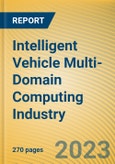Multi-domain computing research: in the coming first year of cross-domain fusion, major suppliers will quicken their pace of launching new solutions.
As vehicle intelligence develops, electrical/electronic architecture begins to evolve from domain control centralized architecture to multi-domain fusion computing/central computing architecture. In this development trend, OEMs, Tier 1 suppliers and chip companies enjoy new market opportunities.
In July 2023, SAIC unveiled a vehicle motion controller (VMC) for central coordination. Based on vehicle central fusion motion control, it enables a shorter cross-domain control link for vehicles, and allows for more efficient control over the body and chassis in the state of human driving or intelligent driving.
In July 2023, BYD first introduced 'Eyes of the God', its advanced intelligent driving assistance system that adopts the central computing platform + zonal domain controller deep collaboration system architecture.
Major Tier 1 suppliers step into the multi-domain computing field by virtue of their own strengths.
From the perspective of layout, Tier 1 suppliers deploy multi-domain computing in a relatively flexible way. They rely on their own superiorities to lay out multi-domain fusion, for example, body and chassis, body and cockpit, and chassis and intelligent driving domains.UAES
UAES has established the special cross-domain control division, and has signed strategic cooperation agreements with ecosystem partners like Horizon Robotics, Neusoft Reach, ABUP, LEADMOVE, and TE Connectivity.In December 2022, UAES released its vehicle computing platform (VCP), which uses the new-generation NXP S32G SoC and integrates functions of power and body domains, including vehicle control, BCM and gateway. For some projects, driving assistance functions are integrated;
In May 2023, UAES launched VCU8.5, a vehicle motion domain controller platform which systematically analyzes and designs the requirements of cross-domain fusion control and integrates such functions as EPB, FlexRay and Delay off.
Continental
In April 2023, Continental exhibited its cross-domain vehicle control high performance computer (HPC) for the first time. In addition to the original body control and gateway functions, this product also integrates chassis control applications. At present, Continental has secured two local orders in China, and the model GAC Aion Hyper GT will become the first production car carrying the product. It is expected that in 2024, this HPC will be installed on more than 30 different models of several automakers.PATEO CONNECT+
In June 2023, PATEO CONNECT+ managed to develop its first vehicle central computing module (CCM). Based on the central gateway, this platform expands computing power, and integrates intelligent cockpit, ADAS, body and vehicle control functions.Key technical support for multi-domain computing: multi-domain computing SoC, and cross-domain fusion software platform.
At present, multi-domain fusion is seen mainly in two aspects: hardware and software. From a hardware integration perspective, multi-domain fusion features multi-SoC integration, that is, different domain controllers are integrated into one box composed of multiple SoCs or MCUs, and different functions are supported by different chips. The multi-domain fusion enabled by a single chip requires a SoC to complete different functions. There are now still some challenges in realizing single-SoC multi-domain fusion.Black Sesame Technologies
In July 2023, Black Sesame Technologies announced C1200, the first product of the Wudang Series. As China’s first automotive cross-domain multifunctional fusion computing chip, C1200 meets the requirements of autonomous driving, intelligent cockpit, body control and other computing functions.Wudang C1200 packs A78AE (performance up to 150KDMIPS), an automotive high-performance CPU core that supports lockstep, the automotive high-performance GPU core G78AE, a built-in mature high-performance Audio DSP module, and the self-developed new-generation NeuralIQ ISP module that processes 1.5G pixels per second online. Moreover, C1200 also has a built-in ASIL-D Safety Island, and a Security Module subject to the National Cryptography Level 2 and EVITA full, meeting the reliability requirements of the highest vehicle safety level.
In addition to chips, the development of cross-domain fusion also needs to be supported by vehicle OS. In current stage, vehicle functional domains have yet to be fully integrated, and there is no intelligent vehicle operating system that can be applied directly for a long time in the world. This is an opportunity for Chinese vehicle OS providers to overtake on the bend.
Arraymo (ArcherMind Technology)
In April 2023, Arraymo, an arm of ArcherMind Technology, launched Fusion OS, a cross-domain fusion vehicle software computing platform which is mainly compatible with operating systems in different domains. Fusion OS quickly connects core functional domains such as intelligent cockpit, central control, and intelligent driving from the bottom layer for high integration of functional modules.The Intelligent Vehicle Multi-Domain Computing Industry Report, 2023 highlights the following:
- Multi-domain computing development ideas, including central domain controller, cockpit-driving integration, integration of cockpit and body domains, integration of chassis and intelligent driving domains, and central computing platform + zone controllers (development, main cases, etc.);
- Key technologies of multi-domain computing, including multi-domain fusion computing SoC, multi-domain computing software OS, multi-domain computing Ethernet, multi-domain computing gateway, and zone controller, (development trends, actual cases, etc.);
- OEMs’ multi-domain fusion development planning, product R&D, technology layout, etc.;
- Chinese and foreign Tier 1 suppliers’ products, technology layout, cooperation, etc. in multi-domain computing and zone controller.
This product will be delivered within 3-5 business days.
Table of Contents
1 Typical Multi-Domain Computing Architecture Ideas
2 Key Multi-Domain Computing Technologies
3 Multi-domain Computing and Zone Controller Technology Layout of OEMs
4 Multi-domain Computing and Zone Controller Technology Layout of Chinese Tier 1 Suppliers
5 Multi-domain Computing and Zone Controller Technology Layout of Overseas Tier 1 Suppliers
Companies Mentioned
- Geely
- SAIC
- GAC
- Great Wall Motor
- FAW Hongqi
- BYD
- Changan Automobile
- Li Auto
- Xpeng Motors
- NIO
- Neta Auto
- Leapmotor
- Volkswagen
- Neusoft Reach
- Desay SV
- PATEO CONNECT+
- Huawei
- Technomous
- UAES
- EnjoyMove Technology
- ThunderSoft
- ArcherMind Technology
- Jingwei Hirain
- G-Pulse Electronics
- Bosch
- Continental
- ZF
- Aptiv
- Harman
- LG Electronics
Methodology

LOADING...








